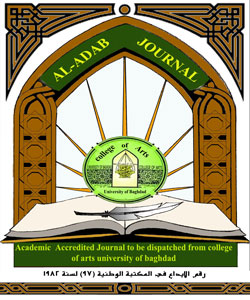Foreshadowing Overuse
A Stylistic Approach to Modernist Fictional Writing
DOI:
https://doi.org/10.31973/vhx0xd55Keywords:
foreshadowing , Mrs. Dalloway, A Portrait of the Artist as a Young Man, corpus analysis, formalismAbstract
As a descriptive study, this article examines the significance of stylistic analysis in observing fiction, focusing on the use of foreshadowing. The author investigates the potential overuse of foreshadowing in selected modern cultural novels and analyses its impact on the plot and the suspense of the readers. The study examines the use of foreshadowing to deconstruct the difficulty novelists face in crafting immaculate works. It concludes that foreshadowing is an integral part of any literary work, regardless of its type or genre, and that it cannot be restricted to particular words. Furthermore, the "tense" factor in most modern works is not fixed or regulated due to the overuse of the flashback technique. The discussion examines Mr. Dalloway by Virginia Woolf and A Portrait of the Artist as a Young Man by James Joyce. Mrs. Dalloway's linguistic variables demonstrate that foreshadowing predominates the plot, as Woolf's foreshadowing lexis continually alludes to Septimus and Clarissa's plight. A Portrait of the Artist as a Young Man heavily uses concrete lexemes to foreshadow Daedalus’ evolution, whereas Mrs. Dalloway focuses on speech and abstract lexemes.
Downloads
References
Barnet, S., E. Cain, W., Burto, W., & Berman, M. (1997). An introduction to literature: Fiction, poetry, drama. Longman Canada.
Buckham, M. (2014). Writing active setting: The complete how-to-guide with bonus section on hooks. Cantwell Publishing.
Cron, L. (2012). Wired for story: The Writer’s Guide to using brain science to hook readers from the very first sentence. Ten Speed Press.
Cuddon, J. A. (1977). A dictionary of literary terms (1st ed.). Doubleday, Garden City, New York.
Duckworth, G. E. (1933). Foreshadowing and suspense in the epics of homer, apollonius, and Vergil .. (dissertation). Princeton University Press, Princeton, New Jersey.
Dupriez, B. 1933-, & W.), H. A. W. (Albert. (1991). A dictionary of literary devices. University of Toronto Press.
Harmon, W. (2002). A Handbook to Literature. (9th ed.). Prentice Hall -Upper Saddle River, NJ, USA.
Jackson, D., & Sweeney, J. (2002). The journalist’s craft: A guide to writing better stories. Allworth Press.
Joyce, James. (2011) A Portrait of the Artist as a Young Man. E-book ed, 2011.
Martinelli, D. (2020). What You See Is What You Hear. https://doi.org/10.1007/978-3-030-32594-7
Noble, W. (1997). Three rules for writing a novel: A guide to story development. Write Thought.com.
Quinn, E. (2006). A dictionary of literary and thematic terms (2nd ed.). Checkmark Books, USA.
Seckel, Al, and Douglas R. Hofstadter (2004). Masters of Deception. 1st ed, Sterling Publishing Co, New-York, USA.
Short, M. H., & Leech, G. (2013). Style in fiction. In Routledge eBooks. https://doi.org/10.4324/9781315835525
Woolf, Virginia. Mrs. Dalloway: Introduction by Nadia Fusini. National Geographic Books, 1993.
Zimbaro, V. P. . A Portrait of the Artist as a Young Man Notes. University of South Florida. Lincoln, Nebraska, USA. 1992.
Downloads
Published
Issue
Section
License
Copyright (c) 2024 Mahdi Shuhaib

This work is licensed under a Creative Commons Attribution 4.0 International License.
Copyright and Licensing:
For all articles published in Al-Adab journal, copyright is retained by the authors. Articles are licensed under an open access Creative Commons CC BY 4.0 license, meaning that anyone may download and read the paper for free. In addition, the article may be reused and quoted provided that the original published version is cited. These conditions allow for maximum use and exposure of the work.
Reproducing Published Material from other Publishers: It is absolutely essential that authors obtain permission to reproduce any published material (figures, schemes, tables or any extract of a text) which does not fall into the public domain, or for which they do not hold the copyright. Permission should be requested by the authors from the copyrightholder (usually the Publisher, please refer to the imprint of the individual publications to identify the copyrightholder).
Permission is required for: Your own works published by other Publishers and for which you did not retain copyright.
Substantial extracts from anyones' works or a series of works.
Use of Tables, Graphs, Charts, Schemes and Artworks if they are unaltered or slightly modified.
Photographs for which you do not hold copyright.
Permission is not required for: Reconstruction of your own table with data already published elsewhere. Please notice that in this case you must cite the source of the data in the form of either "Data from..." or "Adapted from...".
Reasonably short quotes are considered fair use and therefore do not require permission.
Graphs, Charts, Schemes and Artworks that are completely redrawn by the authors and significantly changed beyond recognition do not require permission.
Obtaining Permission
In order to avoid unnecessary delays in the publication process, you should start obtaining permissions as early as possible. If in any doubt about the copyright, apply for permission. Al-Adab Journal cannot publish material from other publications without permission.
The copyright holder may give you instructions on the form of acknowledgement to be followed; otherwise follow the style: "Reproduced with permission from [author], [book/journal title]; published by [publisher], [year].' at the end of the caption of the Table, Figure or Scheme.












